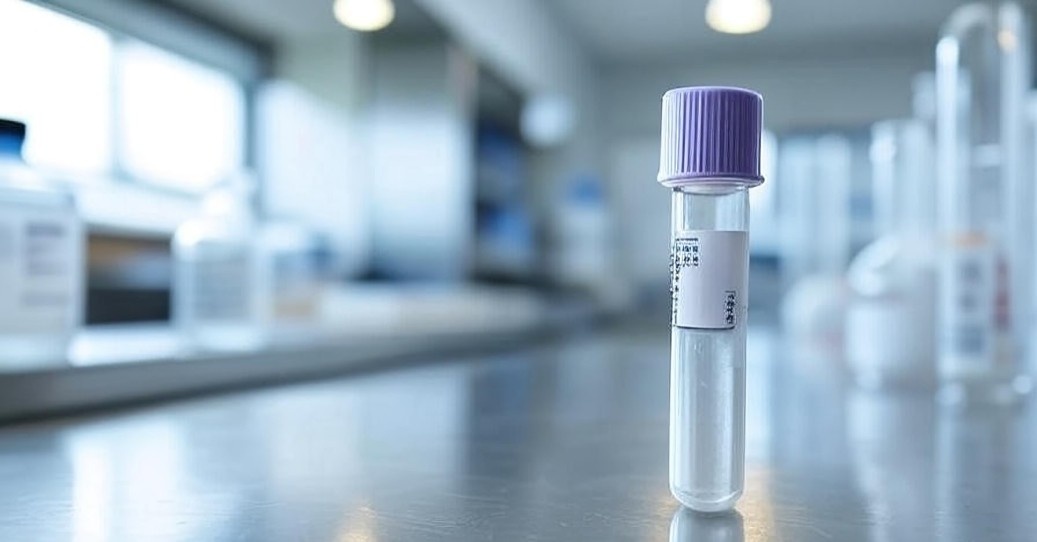During most blood tests today, the sample is collected in a small tube with a purple or lavender cap, known as an EDTA tube. Chances are, your own blood sample was collected this way. But what is this EDTA tube? What is its use? And why is it so important?
Come, let us understand about it easily.

What is an EDTA Tube?
The full form of EDTA is Ethylenediaminetetraacetic Acid. This tube contains a special agent that stops the blood from clotting by targeting calcium, which plays a key role in the clotting process. This EDTA catches the calcium, so the blood remains liquid during the test.
These tubes are mostly made of plastic or glass and their cap is purple or lavender in color. The purple cap on the tube helps identify that it contains EDTA as the anticoagulant. Each color of tube has a different function – like red, green or blue cap tubes have different chemicals inside them.
What is the function of EDTA?
Look, EDTA is a chelating agent – meaning it binds metal ions like calcium, magnesium. This process prevents blood clotting. And the test is done easily.
Types of EDTA:
K2EDTA – in spray dried form
K3EDTA – in liquid form
Na2EDTA – used less
K2EDTA is used the most because it is stable and more compatible with lab machines.
Where is EDTA Tube used?
Hematology (Blood Cell Test):
CBC (Complete Blood Count)
Blood smear
Hemoglobin electrophoresis
In all these tests, the shape of the blood remains the same due to EDTA.
Molecular Diagnostics (DNA/RNA Test):
PCR
Checking the load of a virus like HIV or hepatitis
DNA testing, genetic research
Blood Bank and Transfusion:
Taking a sample for blood matching
Testing for safe transfusion
Research and Trials:
Scientists use blood samples in research
Used in biomarker, DNA studies
Types of EDTA Tubes
Standard Tube: Holds 2–10 mL of blood
Microtainer Tube: 0.5–1 mL, mostly for children
Vacutainer System: Self vacuum, holds only as much blood as needed – no over or under
What is the benefit of EDTA Tube?
Since the blood stays unclotted, it allows for more precise testing.
Shape of cells remains safe
Used for more tests
Can also be stored for a few hours or by keeping in the fridge
By looking at the purple cap, it is known that it is an EDTA tube – there is no confusion
There are some limitations
Not used for every test – if serum is needed, then red-cap tube is required
If the blood volume is more or less, then the result can be wrong
Test has to be done early – remains best for 24 hours
If the tube is shaken forcefully, the red cells break – which is called hemolysis
How to use EDTA tube correctly?
Pick up the right tube – purple cap
Clean the patient’s area
Take blood – using a syringe or vacutainer
After taking blood, gently turn the tube upside down 8-10 times
Label it and store it according to the test
Send to the lab quickly – it is important that the test is done on time
Take care of safety and waste
EDTA tube should be thrown away after using it once – it cannot be recycled or reused. Dispose of it in a proper biohazardous manner.
Some misconceptions about EDTA tube
Myth: EDTA tube is used in every test
Fact: It is used only in blood and DNA/RNA tests. Not for serum test.Myth: It is only for hematology
Fact: It is used in molecular, transfusion, research – everythingMyth: The tube can be reused
Fact: Absolutely not. Use once – then dispose.
People’s questions (FAQs)
1. What is the meaning of EDTA?
Ethylenediaminetetraacetic Acid – prevents blood from clotting
2. Why is there a purple cap?
EDTA is inside the signal
3. Can EDTA tubes be used in chemistry tests like Liver Function Tests (LFTs)?
❌ No. EDTA tubes are not suitable for clinical chemistry tests such as Liver Function Tests.
4. How long does blood remain safe?
The sample remains stable for around 24 hours at room temperature and up to two days if refrigerated.
5. Is there any harm from EDTA tube?
Use it correctly, otherwise it may cause blood damage. Wrong handling may cause blood loss
6. What is the difference between K2EDTA and K3EDTA?
K2 – spray form, more stable
K3 – liquid form, used less frequently
Conclusion
Finally, it is a small tube to look at, but its importance is very great. Blood test is correct with EDTA tubes, DNA analysis is accurate, and it is also useful in medical research. If you are in healthcare or just want to gain knowledge – then now you must have understood well.
If you liked the blog, then share it with others. If you have any questions, then put them in the comments below – we will definitely try to answer them.
Disclaimer:
This blog is for informational purposes only and not a substitute for professional medical or laboratory advice. Always consult a qualified expert for specific guidance.